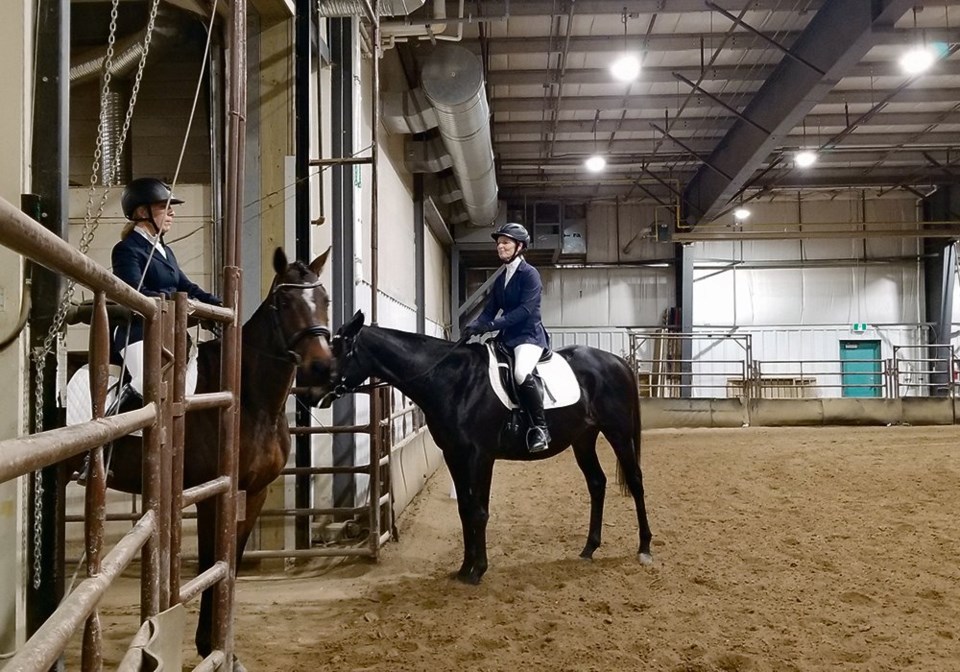Last month at Prairieland Park in Saskatoon, the OTTB (Off-Track Thoroughbred) Challenge aimed to dispel this reputation and show the versatility of retired racehorses.
While the 2021 Equine Expo was cancelled due to COVID-19, the standalone OTTB Challenge was still held in front of about 60 excited spectators.
To prepare, trainers worked with recently retired racehorses. Off-track Thoroughbreds are often still quite young and can easily have a second career. The OTTB Challenge demonstrated the trainability, talent and athleticism of these horses.
The horses that competed in Saskatoon ranged in age from five to 10 years old and included both mares and geldings.
Each horse and trainer competed in two out of five disciplines — an obstacle challenge, dressage, freestyle (including polocrosse and vaulting), hunter-jumper and barrel racing. Awards for each discipline were handed out at the end of the event.
Jody Busch operates Good Start OTTB training in Saskatoon. One of her protégés is nine-year-old Kentucky-born gelding Papa Al, owned by Kierra Funk, who competed in an obstacle challenge and freestyle. The horse was recently in Kentucky for the large-scale Thoroughbred Makeover event where he won the Freestyle Division Best Conditioned Award.
Another Busch horse is named I’ll Tell You Later, or “Bob,” owned by Shannon Dickey and ridden by assistant trainer Anne Hagey.
Along with speed, Thoroughbreds have a reputation for being high-strung and hot blooded. Busch explained that this is when the horse is “racing fit, living in a stall and eating high calorie feed. Older, retired racehorses can actually be quite lazy and nothing really bothers them. Bob is a good example of this.”
With Prairieland no longer holding races at Marquis Downs, it seemed there would be an influx of unemployed racehorses on the market. However, the pandemic has led to much more interest in equestrian sports across Canada. As a result, sound, athletic horses are in high demand.
“People are desperate for horses and prices for off-track Thoroughbreds reflect that. There aren’t a lot of unemployed racehorses right now. With events like this training challenge, we hope to continue to nurture demand for OTTBs and show that they are entirely trainable for a second career in an English or Western discipline,” said Busch.
She describes “two narratives” for the life of a North American racehorse. A two- or three-year-old horse who does not show an aptitude for going fast is already retired by three or four. A good racehorse travels around North America racing and hits retirement at seven or eight years old. In both narratives, the horse is still healthy and has many years ahead to learn new skills like jumping or barrel racing.
The benefits of owning OTTBs include their work ethic, their socialization with humans and the ease of their handling. For example, trouble with trailering and picking up their feet for the farrier are two struggles that OTTB owners can usually avoid.
The downsides can include stable vices such as weaving, cribbing and wind-sucking. These repetitive behaviours are often made worse by long periods of time alone in a stall. Racehorses also have a tendency toward stomach ulcers, due to the high calibre feed and concentrates they ingest as well as their heavy workload at the racetrack.
Busch emphasizes the need for retraining and riding with an experienced rider for a while.
“A retired racehorse is rough and ready. Their first canter is done. They aren’t scared of a person on their back. They can easily go on to eventing and cross-country disciplines because they have no trouble galloping,” said Busch.
Horse trainer Tammy Botsford is a programming manager with the Calgary Stampede. She is a supporter of horse shows and competitions and was happy to travel from Alberta for the OTTB Challenge. Botsford’s two horses, Luvuryan and John’s Quest, competed in the obstacle challenge and a whirlwind round of barrel racing.
Botsford primarily rides Western events and thought she would try something new when she bought her two retired racehorses.
“Thoroughbreds are sensitive and they want to please. They are all heart. The only negatives I’ve encountered are other peoples’ perception that Thoroughbreds are crazy and too tall for barrel racing — neither is true,” she said.
Botsford is happy about the resurgence in prices for Thoroughbreds as recognition of their athletic abilities continues to grow.
“It’s been a strange two years. It’s great that we could hold this challenge and give these retired racehorses a chance at a second career. We need to elevate expectations for everything they can do after racing.”




